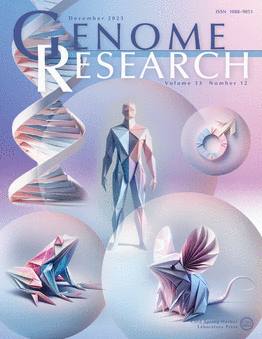有丝分裂染色体在一个普遍的环状阵列构象中包含细胞类型和物种特异性的结构特征
IF 5.5
2区 生物学
Q1 BIOCHEMISTRY & MOLECULAR BIOLOGY
引用次数: 0
摘要
有丝分裂染色体被认为是普遍折叠成环阵列跨物种和细胞类型。然而,一些研究表明,有丝分裂染色体的特征可能是细胞类型或物种特异性的。我们之前报道了CTCF在人类分化细胞系中的结合在有丝分裂中丢失,而有丝分裂小鼠胚胎干细胞(mESC)在CTCF位点的一个子集上显示出突出的结合。在这里,我们对mESCs和体细胞小鼠和人类细胞进行了足迹ATAC-seq分析,证实了这些发现。然后,我们研究了有丝分裂标记CTCF在Hi-C介导的前期中期染色体组织中的作用。我们在mESCs的书签CTCF位点上没有发现任何剩余的相间结构,如tad或环。这表明有丝分裂环挤出蛋白凝缩蛋白I和II不被CTCF阻断,因此维持CTCF结合不会改变有丝分裂染色体折叠。最后,我们将本研究在小鼠中获得的有丝分裂Hi-C数据与人类和鸡的公开数据进行了比较。我们没有发现任何细胞类型特异性差异;然而,我们发现物种之间存在差异。鸡有丝分裂环的平均基因组大小(200-300 kb)小于人类(400-600 kb),尤其是小鼠(1-1.5 mb)。有趣的是,我们发现这种差异与这些物种中q臂的基因组长度有关,我们通过显微镜测量染色体压实证实了这一发现。这表明有丝分裂染色体的尺寸可以通过凝缩蛋白控制环的大小来调节,以促进染色体臂的物种适当缩短。本文章由计算机程序翻译,如有差异,请以英文原文为准。
Mitotic chromosomes harbor cell type and species-specific structural features within a universal loop array conformation
Mitotic chromosomes are considered to be universally folded as loop arrays across species and cell types. However, some studies suggest that features of mitotic chromosomes might be cell type or species specific. We previously reported that CTCF binding in human differentiated cell lines is lost in mitosis, whereas mitotic mouse embryonic stem cells (mESC) display prominent binding at a subset of CTCF sites. Here, we perform footprint ATAC-seq analyses of mESCs and somatic mouse and human cells confirming these findings. We then investigate roles of mitotically bookmarked CTCF in prometaphase chromosome organization by Hi-C. We do not find any remaining interphase structures such as TADs or loops at bookmarked CTCF sites in mESCs. This suggests that mitotic loop extruders condensin I and II are not blocked by CTCF, and thus that maintained CTCF binding does not alter mitotic chromosome folding. Lastly, we compare mitotic Hi-C data generated in this study in mouse with public data in human and chicken. We do not find any cell type-specific differences; however, we find a difference between species. The average genomic size of mitotic loops is smaller in chicken (200-300 kb), compared to human (400-600 kb) and especially mouse (1-1.5 mb). Interestingly, we find that this difference is correlated with the genomic length of q-arms in these species, a finding we confirm by microscopy measurements of chromosome compaction. This suggests that the dimensions of mitotic chromosomes can be modulated through control of loop size by condensins to facilitate species-appropriate shortening of chromosome arms.
求助全文
通过发布文献求助,成功后即可免费获取论文全文。
去求助
来源期刊

Genome research
生物-生化与分子生物学
CiteScore
12.40
自引率
1.40%
发文量
140
审稿时长
6 months
期刊介绍:
Launched in 1995, Genome Research is an international, continuously published, peer-reviewed journal that focuses on research that provides novel insights into the genome biology of all organisms, including advances in genomic medicine.
Among the topics considered by the journal are genome structure and function, comparative genomics, molecular evolution, genome-scale quantitative and population genetics, proteomics, epigenomics, and systems biology. The journal also features exciting gene discoveries and reports of cutting-edge computational biology and high-throughput methodologies.
New data in these areas are published as research papers, or methods and resource reports that provide novel information on technologies or tools that will be of interest to a broad readership. Complete data sets are presented electronically on the journal''s web site where appropriate. The journal also provides Reviews, Perspectives, and Insight/Outlook articles, which present commentary on the latest advances published both here and elsewhere, placing such progress in its broader biological context.
 求助内容:
求助内容: 应助结果提醒方式:
应助结果提醒方式:


